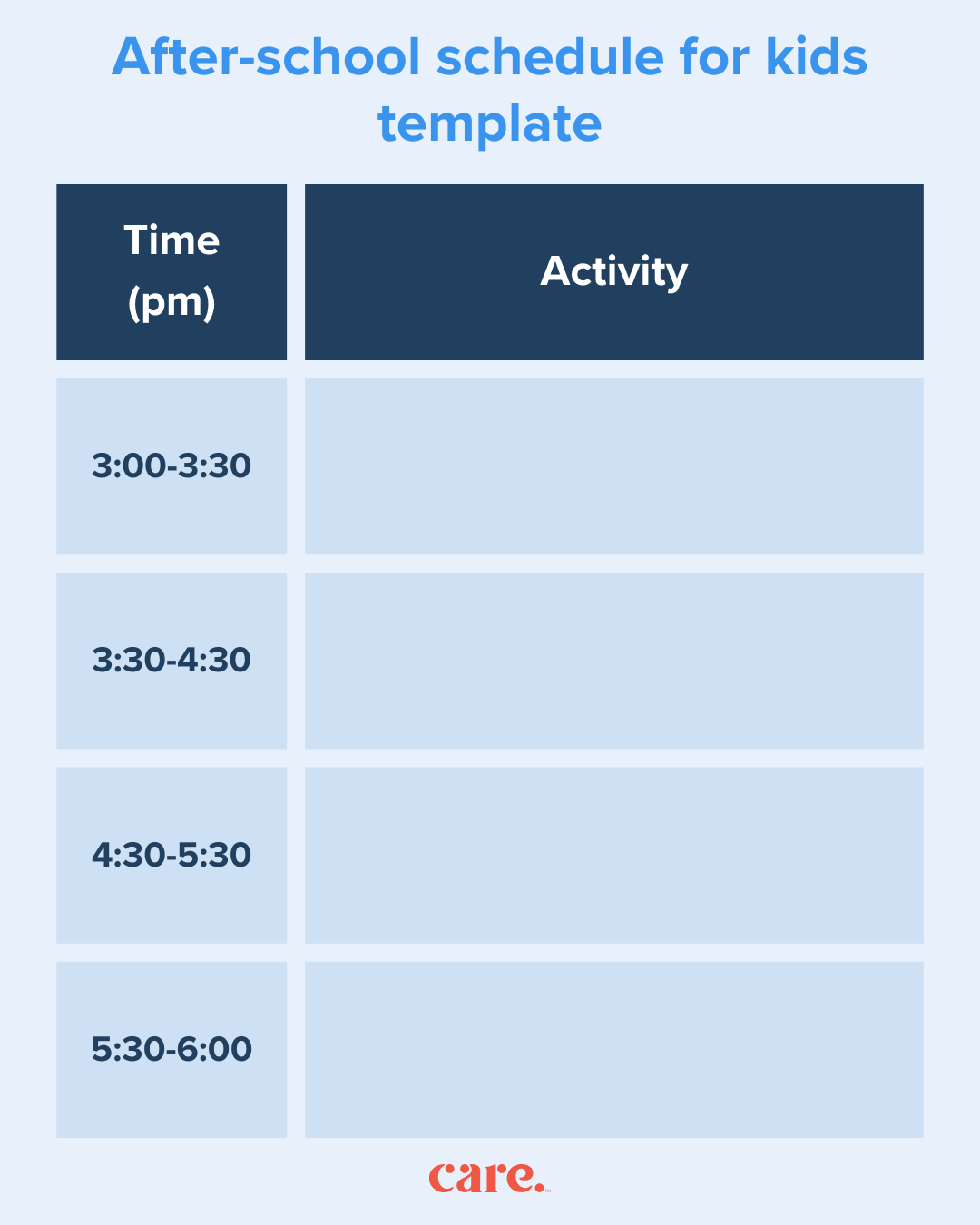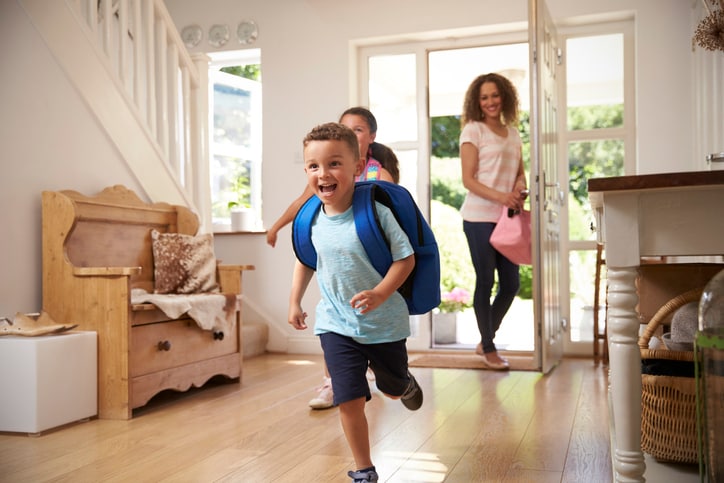In this article
We’ve all been there — kids come home after school, and it’s basically chaos for the next few hours. They’re hungry, they’re cranky and getting them to do homework is a battle. All of this chaos spills into dinner and bedtime, and it becomes near impossible to have a pleasant, restful evening. Whether this sort of thing occurs most days or just some of the time, the way to fix it is usually fairly simple: you need a solid, predictable after-school routine.
“Children who have a good home routine are likely to be calmer, more organized and have greater attention and focus,” says Chana M. Geldzahler, board certified behavior analyst and co-founder and clinical director of Empirian Therapy. “As a bonus, parents and caregivers will also benefit personally from the skills that are honed by having a scheduled evening.”
An after-school routine can help break each part of your child’s afternoon into bite-size, manageable chunks. Let’s take a look at the benefits of after-school routines, how to build a strong after-school schedule and what to do if you run into any challenges with your routine.
Key takeaways
- After-school routines help children transition smoothly from school to home, reducing chaos, stress and crankiness. Consistent routines improve executive functioning, focus, self-discipline and overall mental well-being.
- A balanced routine should include downtime, healthy snacks, designated homework or study time, physical activity and fun. Involving kids in planning ensures the schedule meets their needs while fostering a sense of control and responsibility.
- Even the best routines may need adjustments based on behavior or feedback, and consistency is key to success. Tracking progress, listening to your child and seeking professional guidance if needed helps create a predictable, calming environment for the whole family.
What are the benefits of having an after-school routine?
All of us benefit from having healthy routines in life, and this is especially true for children. Research shows that routines for children are linked with positive cognition, better self-control, improved social-emotional health and growth in academic skills. Here are some of the other benefits of after-school routines, according to the experts we spoke with.
Executive functioning
One major area that strong after-school routines help with is executive functioning skills, Geldzahler says. This includes time management, self-management and organization. After-school routines can also improve your child’s concentration skills, which aids in their ability to focus on homework and any other tasks they have to accomplish.
“When children have designated times for homework, physical activity and relaxation, they also start to develop self-discipline and time management skills.”
— L’Taundra Everhart, special education supervisor
Mental health
“When kids have a set routine to follow after school, they are more likely to develop good habits and behaviors,” says Dr. Michelle Beaupre, licensed clinical social work and clinical director at Villa Oasis. “This can lead to positive changes in their mental health, as they will feel less stressed and anxious when they have a structured routine to follow.”
Decreased burnout
These days, with jam-packed schedules and increased homework, many kids are overworked. This can lead to feelings of burnout. Dr. Beaupre says that a good after-school routine can address this. “With a good after-school routine, a child will have designated times for each task, giving them enough time to complete them without feeling overwhelmed,” she explains.
Strong work ethic
Doing schoolwork as part of an after-school routine rather than on a loose schedule — which may end up being five minutes before bedtime — can help develop a strong work ethic, says L’Taundra Everhart, special education supervisor at Cincinnati Public Schools and founder of Mixed Greens for the Soul. “When children have designated times for homework, physical activity and relaxation, they also start to develop self-discipline and time management skills.”
Better sleep
Good after-school routines can also help kids manage their moods and wind down at the end of the day. “A child who doesn’t have a good home routine might go to sleep and wake up late, not get enough sleep and be rushed while getting ready for school in the morning, which doesn’t set them up for a productive school day,” Geldzahler describes.
Join Care for free
What should be included in after-school routines?
So, let’s get down to business. What are some things to do after school that you should include in an after-school routine? What are the key elements of a functional plan? Here’s what Beaupre recommends:
- Rest. Children need plenty of rest after a long day at school, so schedule in down-time for relaxation and recharging a child’s batteries.
- Snacks. Snacks are important! Kids need to refuel after-school. Make sure to have healthy snacks on hand, as this will give kids the energy to get through their school work and other activities.
- A set amount of homework and study time. Make sure to designate a time each day for this, rather than cramming it in at the last minute or between other activities. Calculate in homework and study breaks.
- Most importantly, don’t forget fun. It’s important for kids to have time each day to just be kids, whether that be playing outside, watching a favorite tv show or reading a book. These activities help kids destress and relax.
Sample after-school schedule
What does an after-school routine look like? Everhart offers an easy-to-follow sample that combines all of the elements listed above.
| Time (p.m.) | Activity |
| 3:00-3:30 | Downtime: Allow kids to engage in free play, reading, drawing or playing with toys. |
| 3:30-4:30 | Healthy snacks and physical activity: Give kids a chance to refuel with nutritious snacks and get the body moving with activities like dancing, yoga or outdoor play. |
| 4:30-5:30 | Homework and study time: A designated focused block for completing schoolwork, with parental/caregiver support as needed. |
| 5:30-6:00 | Family time: Engage in a shared activity, such as a family game night, cooking together or simply chatting about each other’s days. |
Download this free after-school schedule template

(Click to download this after-school schedule template as a PDF.)
How to create personalized after-school routines
When creating an after-school routine, parents and caregivers should consider each child’s needs, obligations and energy levels, Beaupre says. “Really getting to know where your child is coming from and what they need can help create a routine that fits their individual needs,” she notes.
Each family has different scheduling needs and obligations as well. How to do this, exactly? Geldzahler offered the following tips:
- Go over each family member and caregiver’s schedule, noting essential activities and tasks that need to be done between the time the child gets home and when the child goes to bed.
- Make sure to involve kids in the brainstorming and set-up process, taking into account their preferences and ideas.
- Before finalizing the schedule, measure how long it takes to complete each activity, and then create the completed schedule accordingly.
Ultimately, parents and caregivers will have a final say in creating a schedule that meets everyone’s needs, but getting kids’ input can result in a better schedule for everyone.
“Really getting to know where your child is coming from and what they need can help create a routine that fits their individual needs.”
—Dr. Michelle Beaupre, licensed clinical social worker
How to know if you need to adjust your after-school schedule
Let’s face it: even with the most well-planned and considered after-school routine in place, things don’t always go as planned. It’s common to have challenges pop up along the way — the most common being that the routine simply isn’t working or kids are no longer compliant.
Here are Geldzahler’s tips for managing any pitfalls that may come up with your after-school routine:
- Track how things are going by using a chart or journal to note daily tasks and pinpoint when any problematic behaviors occur.
- Review the routine to determine if adjustments are needed. Frequent behavioral problems during a specific transition or task indicate that you might need to tweak the schedule.
- Be consistent with the routine, as inconsistency increases non-compliance and behavioral issues.
- Talk to your child and listen to their feelings about the routine; consider modifying the routine if the child has reasonable concerns.
Know that challenges are to be expected, especially if you have recently gone from no structure to a solid routine. Finally, if you continue to struggle with implementing a routine, reach out to a professional for advice, such as your pediatrician, a child therapist or a behavioral specialist.
The bottom line on after-school routines
Establishing an after-school routine takes time and patience, but once implemented, you will likely find that kids are much happier, calmer and more productive. This means that you, too, can manage your daily afternoon and evening responsibilities with greater ease.
“I’ve seen firsthand how a predictable routine helps kiddos feel more grounded and secure, allowing them to transition from the school hustle into the home environment with ease, which means fewer meltdowns and more time to recharge,” Everhart says.
When children and adults have a sense of structure and predictability at the end of the day, it does wonders for their overall well-being, she concludes.





